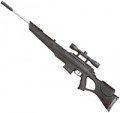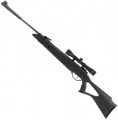Type
The type describes the basic operating principle of the rifle. Nowadays, you can find pneumatics with
a spring-piston operating principle (with a regular or
gas spring), with
pre-pumping (PCP), with pumping before each shot (
multi-compression rifles), with power
from carbon dioxide cartridges and with
an electric drive. Here is a more detailed description of each of these types:
— Spring-piston. As the name suggests, the mechanism of such rifles is based on a spring-loaded piston moving in a cylinder. The weapon is cocked manually (usually by a lever or by breaking the barrel), with the piston being pulled back and fixed, the cylinder being filled with air, and when the trigger is pulled, the piston is released and moves forward under the action of the spring, pushing the air out of the cylinder into the barrel. Rifles of this type are distinguished by their simple and reliable design, low cost, low maintenance, and ease of repair and tuning; they are considered an ideal option for beginner shooters, as well as for fans of entertaining short-range shooting, and there are also airsoft models among them. It is also worth mentioning the excellent repeatability of shots (with each cocking, a strictly defined portion of air enters the cylinder) and insensitivity to he
...at and cold. On the other hand, such rifles require cocking (and most often reloading) before each shot, which can be quite tiring; and the operation of the piston mechanism creates a specific recoil, which negatively affects accuracy and complicates the search filter of optical sights (special optics are required, originally intended for such use). In addition, this type of pneumatics cannot be kept charged for a long time - with prolonged compression, the mainspring loses its properties.
— With a gas spring. In general, the operating principle of this type of rifle is similar to the spring-piston rifles described above. The difference is that instead of a conventional metal spring, they use a sealed reservoir with a special gas, which acts as a spring — compressing when cocked and expanding when fired. This design has a number of advantages over a conventional spring-piston rifle. Firstly, the entire mechanism operates much smoother and quieter, and the recoil is softer, which improves accuracy and simplifies the search filter of optics. Secondly, the gas spring does not change its properties as it wears out, and such a weapon can be stored even in a cocked state. Thirdly, repairs and maintenance for gas springs are required less often and are cheaper (in terms of the number of shots between visits to the workshop). The disadvantages of this type of rifle, in addition to the need to cock the spring before each shot, include a slightly higher cost than classic spring-piston rifles, as well as sensitivity to cold: as the temperature drops, the gas pressure in the spring decreases, which reduces efficiency.
— PCP (pre-pumping). The source of energy in rifles of this type is a built-in reservoir containing air (or another gas) under very high pressure — about 200 or even 300 atmospheres. This reserve is enough for at least several dozen shots, and a compressor, a scuba tank or a special high-pressure pump can be used to fill the reservoir (sometimes such pumps are even supplied in the kit). In general, PCP is considered the most advanced type of pneumatics; it is these rifles that professional hunters and sportsmen use. This is primarily due to the fact that such a design allows for a very high bullet speed, and the recoil is almost imperceptible — all this allows for accurate shooting even at long distances. With a fresh gas, the rifle gives excellent repeatability of shots; however, as the gas is consumed, the initial speed of the bullet decreases, but advanced models may be equipped with a reducer that compensates for this phenomenon (for more details, see "Air supply with a reducer"). PCP pneumatics can be easily made multi-shot and provide very simple and convenient ways of feeding the next bullet into the barrel. The main disadvantage of such rifles is the high price.
— Multi-compression. Another type of rifle with a built-in reservoir; however, unlike the PCPs described above, the reservoir must be pumped up before each shot. For this purpose, the design provides a built-in pump controlled by a lever or other similar device; to pump in a sufficient amount of air, as a rule, you need to make several movements. Such rifles have virtually no recoil, while they are noticeably simpler and cheaper than PCP pneumatics, but inferior to it in power. In addition, pumping up the reservoir before each shot is quite a tedious task; and the volume of air supplied to the reservoir with each filling (and, accordingly, the working pressure in the reservoir) will depend on the number and amplitude of movements made by the pump lever. On the one hand, this allows you to adjust the power directly "on the go": for example, for a short range, where the maximum bullet speed is not required, you can pump the rifle not completely in order to save energy. On the other hand, the actual volume of air and pressure in the reservoir will be slightly different with each reload, even with the same number of lever movements. This has a negative effect on the repeatability of shots. Due to this combination of features, multi-compression models are not very popular these days, and their purpose is mainly recreational shooting.
— Gas cylinder. A type of pneumatics that operates from replaceable gas cylinders, usually liquefied carbon dioxide. Like PCP, such a reservoir allows you to make a lot of shots — even a traditional 12-gram cylinder is usually enough for several dozen; and some models use containers for 88 g of carbon dioxide. At the same time, the rifles themselves are cheaper than PCP, but have less power. It is also worth noting the rather specific characteristics of carbon dioxide as an energy source. On the one hand, it maintains working pressure for quite a long time — it does not decrease as long as liquid carbon dioxide remains in the cylinder. On the other hand, the actual gas pressure depends on the ambient air temperature, and the initial velocity of the bullet in such pneumatics can change significantly even with daily temperature fluctuations. And one of the clear disadvantages of such rifles is that you have to buy not only bullets for them, but also gas.
— AEG (electrically driven). Pneumatics that use an electric motor drive as a source of energy. In terms of the design of the working mechanism, it is similar to a spring-piston one — the basis of this mechanism is a cylinder and a spring-loaded piston. However, in this case, the piston is not pulled back manually, but with the help of the aforementioned electric motor. For the shooter, this means, first of all, that the rifle does not need to be cocked by muscle force — to fire, it is enough to press the trigger, the electric motor will do the rest. In addition, in such pneumatics, an automatic shooting mode can be easily provided (see below). Note that for a number of reasons, this operating principle is practically not found in traditional pneumatics, but it is very popular in airsoft models; such rifles ("drives") often copy real combat weapons.Muzzle velocity
The muzzle velocity provided by the rifle - that is, the speed of the bullet as it exits the barrel.
All other things being equal, a higher bullet speed provides greater range and accuracy, and also simplifies aiming at long distances: the bullet flies along a smoother trajectory and requires fewer adjustments in height, and the influence of side winds decreases with increasing speed. On the other hand, this indicator directly affects the price of the rifle; and in some countries, legal restrictions on the ownership of pneumatic weapons are also related to the muzzle velocity of the bullet.
As for specific values, in the weakest modern rifles the initial speed does not exceed
150 m/s, and in the most powerful it can be
300 - 350 m/s or even
more(remember, the speed of sound is 330 m/s). In general, for recreational shooting at short distances, this parameter is not particularly important, and detailed recommendations for choosing pneumatics for more specific situations can be found in special sources. Let us only note that in AEG electric drives (see “Type”) the initial speed extremely rarely exceeds 150 m/s, but this is done solely for safety reasons: such “weapons” are intended for military-tactical games and initially involve shooting at people, and the high speed would be unsafe for players even with protective equipment.
It is also wor
...th considering that this indicator is not strictly defined. In any type of pneumatic it depends on the weight of the bullet (the lighter the faster); therefore, in the characteristics it is usually customary to indicate a certain average velocity for standard ammunition (usually weighing 0.5 g, in AEG - 0.2 g). In addition, in multi-compression rifles the actual speed of the bullet is determined by the degree of inflation, in gas-cylinder rifles it is determined by the ambient temperature, and in PCP models it is possible to achieve higher speeds than declared by replacing the air with a special gas (for example, helium). Nevertheless, this characteristic makes it possible to evaluate the capabilities of the rifle and compare it with other models, including those that differ in type.Fuse
The type of safety provided in the design of the rifle.
Recall that the fuse is a device that prevents an unwanted shot. In air rifles, such a device can be
automatic or manual, and in some models it is absent altogether. Here are the features of each option:
— Manual. Fuse, switched on and off exclusively manually, at the will of the shooter. The most common variety — such mechanisms are as simple and inexpensive as possible. They are somewhat less safe than automatic ones (see below) and require more careful attention; however, it is not difficult to develop the skill to properly handle the manual safety. And in multi-shot models, the advantage of manual safety over automatic is that there is no need to make unnecessary actions between shots.
— Automatic. A fuse that, at a certain moment, works automatically, without additional actions on the part of the shooter. Most often, such systems operate in this way: the weapon automatically becomes on the safety lock after the trigger is cocked, and in order to make a shot, you must first turn off the safety lock manually. This provides more safety than in the manual systems described above: if the shooter forgets about the fuse, the shot will not happen anyway. Particularly popular are automatic safety locks in cocked rifles due to a broken barrel (see "Cocking System"): such a mechanism does not allow you to pull the trigger until the shooter has completed relo
...ading. But in other types of pneumatics, this option is rare.
In addition, this category may include systems that are not fuses in the original sense of the word — for example, a mechanism that prevents the bullet from feeding into the chamber of a PCP rifle (see “Type”) if there is already a charge there.
— Is absent. No separate fuse. A similar design is found in two varieties of air rifles. The first is low-cost models with a spring principle of operation (including those with a gas spring; see "Type"). In such models, the fuse is abandoned solely to simplify and reduce the cost of construction; it is worth buying such a rifle only if the future owner knows the safety rules when handling weapons.
The second type of pneumatics without fuses are high-end PCP rifles designed for professional shooters. Similarly, the role of the "fuse" when using such weapons is played exclusively by the skills and experience of the user himself.
